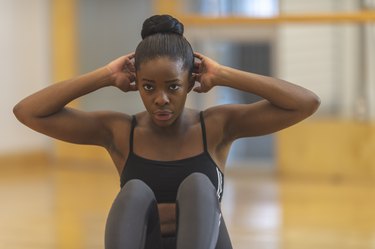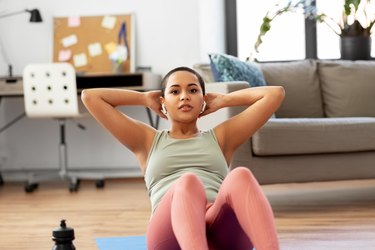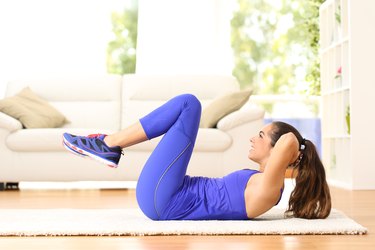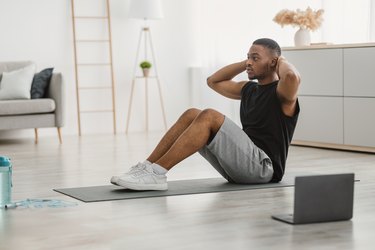
Sit-ups are a staple exercise in most core workouts routines. And while they may look easy to do — all you're doing is lifting your torso up and down, right? — you actually need a lot of core strength and stability to perform them correctly.
So, if you're looking to improve on your sit-up form and the amount you can bang out at once, we've got you covered.
Video of the Day
Ahead, learn how to do more sit-ups correctly as as well as other moves that build endurance in your core. Consistent workouts and doing sit-ups on a regular basis will help you improve quickly and effectively.
3 Tips to Help You Get Better at Sit-Ups
1. Pay Attention to Your Form
One of the fastest ways to improve your sit-ups is by slowing down. Slow and controlled movement makes your muscles do the work, rather than momentum, Yusuf Jeffers, CPT, a coach at ToneHouse and Mile High Run Club, previously told LIVESTRONG.com.
Slow sit-ups also mean you pay attention to form so you can prevent injury and build strength in the right places. Visualize your abs working as you crunch up, particularly during the first portion of the lift. Pull your belly button in toward your spine to truly engage your abdominal muscles. Keep your back flat and don't use your arms to help you swing up — generate the energy from your core.
2. Stay Consistent
Regularly doing sit-ups is essential in improving them. Do a baseline test to see how many you can crank out, with good form, in 2 minutes. (This test used to be done by the U.S. Army, but they've since replaced sit-ups with a plank hold.) Divide this number by three to find how many reps you should include going forward in each set at workouts. For example, if you performed 60 sit-ups in 2 minutes; divide 60 by 3 to get 20 reps per set.
Three days per week, plan to do a core workout that includes three sets of the reps determined by the test above. In our example, the person would do three sets of 20 sit-ups. Recover 30 seconds between sets.
The sit-ups, though, are only part of a total core-strengthening routine. Create a balanced core to keep your body healthy and promote overall abdominal endurance. Your routine might look like:
- Warm up with five minutes of light cardio, like marching in place or riding an exercise bike.
- Finish warming up your abs by slowly bending side to side and twisting right to left. Do side bends and rotations for about 30 seconds each. Finally, alternate pulling your knees up to your chest for 30 seconds.
- Do the three sets of sit-ups as prescribed by your two-minute test.
- Do three to five additional abdominal and back exercises, including a 60-second plank hold, three sets of 10 reps of bicycle crunches, three sets of 15 reps of bird dogs and 30 seconds of holding side plank on the right and the left.
- Stretch to cool down. Perform the cobra and bridge yoga poses, for example.
3. Test Your Progress
Once every two weeks, give yourself another timed sit-up test. Amend your workout accordingly — increase or decrease the amount of sit-ups you're doing. Regularly performing a self-administered test helps you learn how to pace so you don't start out too fast and fizzle by the end. It also helps you see progress as you get stronger.
3 Exercises to Help You Improve Your Sit-Ups
Strengthening your abdominal muscles can help you to improve your sit-up technique and the amount of sit-ups you're able to complete. You can strengthen these muscles with the following exercises.
1. Forearm Plank
The forearm plank can help strengthen the muscles you use to do sit-ups. It targets your back and abdominals, but also includes the trapezius, rhomboids, rotator cuffs, deltoids, pectorals, serratus anterior, gluteus maximus, quadriceps and calves.
- Get down on all fours on the floor and put your elbows and forearms on a comfortable surface (like a mat, towel or carpeted floor).
- Extend your legs back behind you and push up into a plank, creating a straight line from your shoulders to your ankles. Keep you neck in neutral alignment by looking at your hands.
- Hold this position without moving. Keep your hips level and squared to the ground and don't let your lower back arch.
2. Cobra Pose (Bhujangasana)
The cobra pose can help to stretch and open out your stomach muscles and counteract the curling forward action of sit-up exercises.
- Lie on your stomach with your legs together, the tops of your feet down and your hands under your shoulders.
- On an inhale, peel your chest away from the floor. Roll your shoulders back and down your spine as you straighten your arms as much as your flexibility allows.
- Be careful not to go too far too soon. Breathe deeply and maintain awareness of the feedback your body is providing to avoid stress or strain.
- Lower your chest back down to the floor in the starting position.
3. Single-Leg Balance
Balancing on one leg encourages your abdominal muscles to engage. You will also use your glutes, quads, hamstrings, adductors, soleus, calf, tibialis anterior and obliques.
- Stand with your feet hip-width apart and ensure your shoulders are down and back, your spine is straight and your weight is spread evenly.
- When you're ready, bend your right knee and lift your right foot a few inches from the floor. Use your stomach muscles to stabilize your body and avoid the temptation to tilt to one side.
- Hold for 15 seconds.
- Repeat on the opposite side.
Tip
To make this exercise easier, hold onto the back of a chair for balance. To make this exercise harder, lift your foot higher, close your eyes or hold your arms above your head as you balance.
The Bottom Line
The fastest way to get better at sit-ups is to slow down. Make your muscles do the work instead of using momentum. If you need to work on your core strength more to be able to nail proper sit-up form and/or increase the number of sit-ups you can do at one time, exercises like the plank, single-leg balance and cobra pose can help.
The Centers for Disease Control and Prevention (CDC) recommends that adults strength-train all major muscle groups — like your core — at least twice a week. Take rest days in between each sit-up training session to let your muscles recover and prevent injury.


